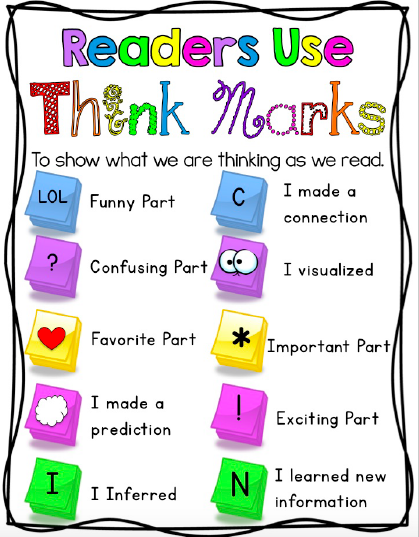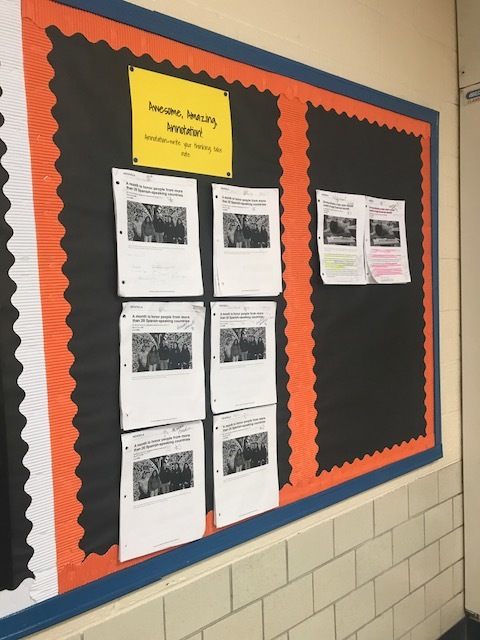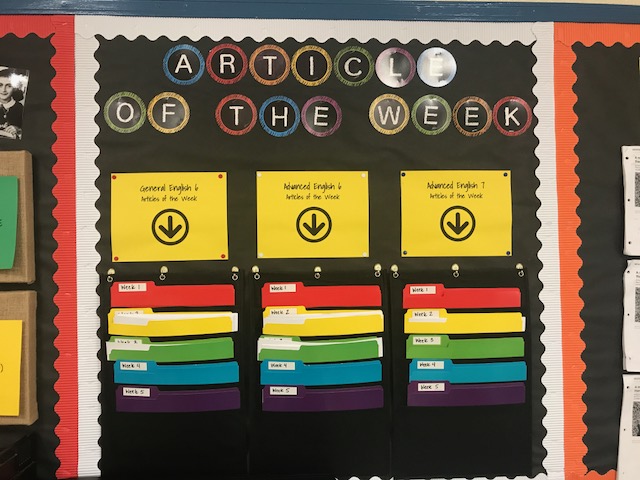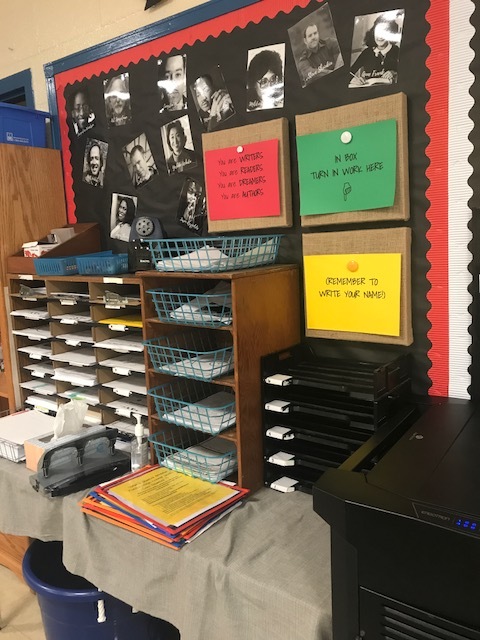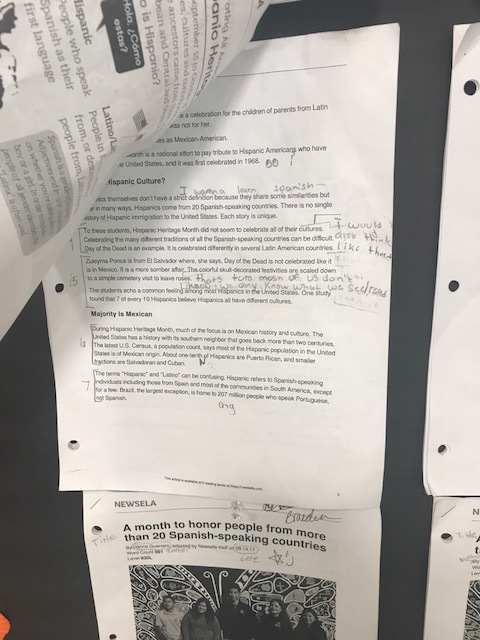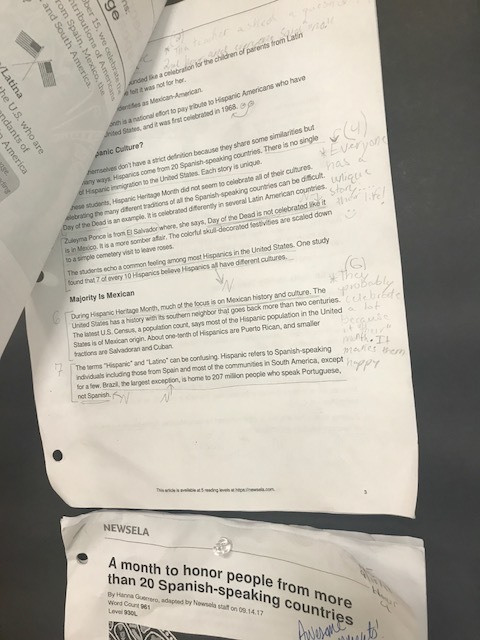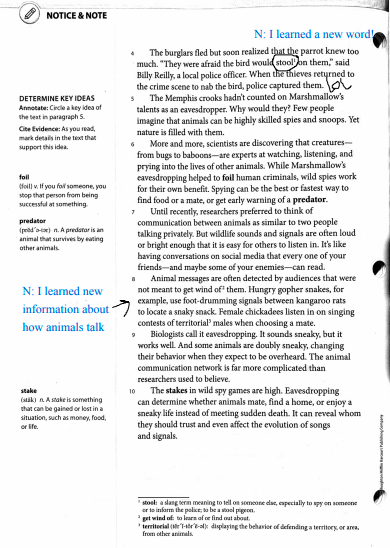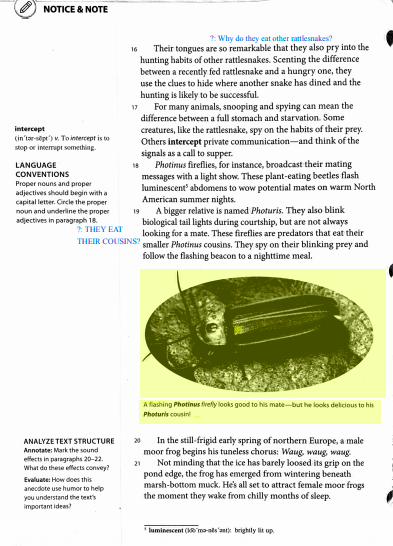Why the First Skill I Teach is Annotation
Show Your Thinking on Paper
The first six weeks of back-to-school are filled with getting to know students, testing, and figuring out our classroom routines. When we get into the second marking period, I always notice a shift in how my classroom does its business. There is a movement from the “getting to know you phase” to the “we can finally start learning and growing phase” each year. This phase takes place right around the six-week mark and involves focusing more on content than on routines and expectations. I look forward to this transition each year. I want to take a moment to pause and acknowledge the first skill that I teach students every school year is always the same: annotation in reading. I use non-fiction reading to implement this strategy because it establishes a routine for the rest of the year when we encounter a nonfiction text, and it transitions nicely to when we are dealing with larger works of fiction. In the past, I have done Article of the Week from Kelly Gallagher to teach annotation skills, but I am finding that online learning is causing me to adapt to a new way to teach annotation while online. Annotation is a brand new skill for middle-schoolers. In this post, I will outline how I go about teaching annotation skills, providing purpose for annotation, and how to keep mixing it up to keep kids interested.
Why Annotation. Why This Skill.
In my tenth grade year of high school, my high school English teacher and later on my mentor teacher started to teach us annotation using Ralph Waldo Emerson's "The American Scholar" and "Self-Reliance." She assigned the reading one night, and the next day we entered her classroom utterly confused. She then went back and taught us how to annotate our reading as a means to clarify the confusion. While I don't often like to send students into the wilderness of reading without guidance, I think that this strategy provided her some valuable information that I find my students struggle with to this day: Students get lost in reading and can't find their way out. Sometimes the wilderness of reading is too wild and students choose not to enter it at all. While the wilderness is beneficial when exploring, we don't want to get stuck in the wilderness with no water, no food, and no shelter. Annotation is the survival guide. The annotation also provides a roadmap.
Thinking through the text and showing evidence of your thinking is a throwback skill to elementary school teachers and middle school teachers stopping to demonstrate their thinking as they read. It is as natural as the anchor chart. Annotation is the action of writing your thinking on the page. It starts in stages. Often, students will get caught up in the reader's response and engage in reactionary almost comic book-like reactions such as: WOW, WOAH, AWESOME, OMG, IDK, etc. While these are great reactions that demonstrate thinking and interaction with the text, teachers must help students define what the purpose of annotation while reading a text. I find these are the three main ways of helping students find purpose while they annotate:
Read to comprehend (main idea, points, messages, vocabulary, context, etc)
Read to connect (text to self, text, and world)
Read to question (asking, pondering, wondering)
I will often outline suggested "purposes" for annotations when looking at both fiction and non-fiction pieces of work. The reason why I love annotation so much is that students get to show me that they have an opinion. This work is increasingly critical for our students who struggle with reading because they often haven’t been taught this habit before: Good readers have thoughts and opinions about what they read. They get to show me that their thoughts matter. This is more than a diagnostic; it is an intervention. There are more than these three main ways of helping students find purpose in the text; however, I constantly keep coming back to them as my standbys that never seem to get old.
How to Introduce Annotation to Middle Schoolers
When we talk about annotation with middle schoolers, we have to acknowledge that this is a brand new skill. It will be a process of lessons and feedback in order to show them the importance of quality annotation while reading either fiction or nonfiction texts. Two of my favorite things to call annotations are “think marks” and “SNOTS or Small Notes on the Side” (Cue fun lines like, “where are all of your boogers?”). These phrases are a little bit more user friendly in terms of reinforcing why we write on a piece of text. Students pick up right away on the use of symbols-more so than comments. I like to use this free handout from Just A Primary Girl on Teachers Pay Teachers. It's awesome. Once they seem to master symbols, I will urge them to find a certain number of comments throughout the pages of their reading. All the while providing examples of great annotation at each level. I am also a fan of introducing fun highlighters, pens, and markers. However, you have to proceed with caution due to the love of coloring. The purpose is key. Purposeful coloring is great for readers, a whole yellow neon page will be completed immediately unless students are instructed otherwise. I like to use common codes as well. I have all students circle words they don't understand. I also have students underline important phrases that need to be noted for questioning, connections, or comprehending. Using these systems, students are able to interact with the text while reading.
Adapt Annotation to Online Learning
For the transition to online learning, you may feel the same nostalgia I did of wanting to hand out a paper article and a pencil and go to town. However, we have to adapt. Kami is a great tool that allows students to annotate and write on a piece of text in a virtual setting. It features a voice tool, highlighting and markup, text boxes, and a drawing tool. I am even considering how this can create fillable PDFS for other types of writing assignments such as longer essay assignments that will need to be taught from a distance.
Here is a snapshot of the Kami toolbar with a PDF that was assigned through Google Classroom:
Here are two closeups of my favorite tools: Markup and drawing.
Article of the Week Assignment
The most common way I reinforce annotation habits is through the doing of the act of annotation over and over. I will count annotation as a part of their grade for a given assignment. For students that do not write comments on their articles, I write "not yet" and allow them to resubmit. They have to get this. They have to get this concept now before all else. For seventh grade, I immediately start looking at the quality of their annotation. I ask myself, "Is this something that shows critical thought or reactions with reader's response?" I will also ask them questions that start to introduce them to the other realms of critical theory (even though I don't call it this in 7th grade). Those questions might look like this:
Social Class Questions to Consider:
Who benefits in the text if they have money?
Who is hurt in the text if they don’t have money?
What values does the text support? (Values=judgment of what is important in life)
Who is given power? Who is powerless?
Feminist/Gender Questions to Consider:
How are men/boys presented in the text?
How are women/girls presented in the text?
Are the relationships between men and women positive or negative?
Which gender seems to have more power?
Does each gender seem to have a “job” or role?
The Article of the Week will shift focus throughout the course of the year. Sometimes we will focus on non-fiction summary writing, sometimes we will focus on the structure or organization of the text. At all times, we focus on annotation and reactions that will lead to purposeful discussion and dialogue.
Annotation Examples
ARTICLE OF THE WEEK
In my classroom’s physical space, I have a wall where I keep examples and directions.
KAMI ASSIGNMENT EXAMPLE
Mix It Up
In order for students to remain interested and to also keep increasing their skills in annotation, the focus can shift depending on the assignment and where each class is in a particular unit. For example, there could be:
Annotation for Beginners (Students learn how to write on the page)
Annotation for Discussion and Dialogue (Students bring annotations as discussion starters)
Annotation for Writing Style (Mentor Texts)
Annotation for Vocabulary Acquisition
Annotation for Critical Theory Responses
And more! The goal is to provide purpose for annotation. While the first go-around I am making sure that kids know it is okay to write on the paper, this shifts quickly so that students realize annotation is more than writing thoughts down. It is showing the complexity and nature of their thoughts in reaction to ideas. It matters.
Annotation Resources
ReadWriteThink: Teaching Student Annotation: Constructing Meaning Through Connections
Dave Stuart, Jr: Purposeful Annotation: A “Close Reading” Strategy that Makes Sense to My Students
BrightHubEducation:Have Your Class Write Annotations: Teacher Tips
WeAreTeachers: Reading With Pen in Hand: Teaching Annotation in Close Reading


